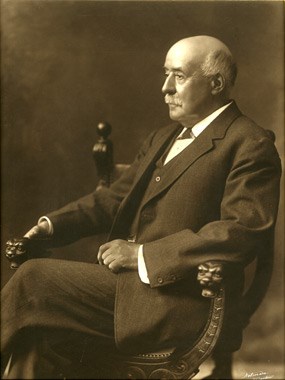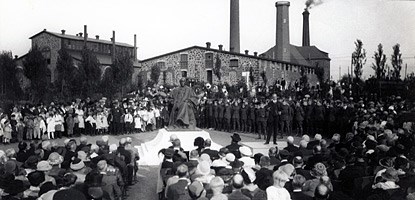
Alexander Agassiz died at sea in 1910, but his presence is still felt in Calumet today. At the same time he was leading the Calumet and Hecla mine to international fame, Agassiz was influencing nearly every aspect of life in the community that developed around it. Massive warehouses, tall smokestacks, stately office buildings, and other industrial structures demarcating the former mine site reflect his managerial approach, but Calumet's schools, libraries, and churches also bear his stamp. Less obvious, but perhaps more evocative, are the local traditions, beliefs and attitudes that his policies helped shape. It is impossible to separate this complex, accomplished, and driven man from Calumet's history. Agassiz was born on December 17, 1835 in Neuchatel, Switzerland. His father was the noted naturalist Louis Agassiz. His mother, Cecile Braun Agassiz, also had an interest in natural history. Not surprisingly, the young Agassiz shared their enthusiasm for the outdoor world, and often accompanied his father through the countryside on expeditions. His mother taught him to illustrate the plant and animal specimens he found. She also made music a part of their daily activities. In 1846, Louis Agassiz immigrated to the United States, leaving his wife and children to stay with relatives in Germany. Their family was torn apart once again when Cecile died during the summer of 1848. Agassiz remained in Germany with an uncle, while his two sisters returned to Switzerland to live with their aunts. Agassiz joined them on vacations from school, but in the spring of 1849, Louis — who was by then a professor at Harvard — sent for Alexander to join him. He arrived in Cambridge, Massachusetts in mid-summer, after a trans-Atlantic voyage of some forty-five days. On his arrival, Agassiz became part of his father’s eccentric household, which included "a dear old artist," a Harvard student, and "an old Swiss minister." He also shared quarters with "a bear, some eagles, a crocodile, a few snakes, and sundry other live stock." The intellectual stimulation presented by this unconventional environment was supplemented by a more traditional education: he attended Cambridge High School, which was known as one of the best college preparatory schools in the country. When Agassiz's father remarried in the spring of 1850, his daughters rejoined the family. Their stepmother, Elizabeth Cabot Cary, brought a sense of stability to their home; it remained one of Cambridge's intellectual centers, where many of the brightest minds met and ideas flowed freely. Agassiz's intellectual nature was balanced by a solid pragmatism. After graduating from Harvard in 1855 with a degree in science – which he completed while being a member of the rowing team – Agassiz entered the engineering department at the Lawrence Scientific School. He also helped his stepmother establish a school for girls to bolster the family income; he kept the account books, and taught math, chemistry, physics, French, and Latin. Even with these responsibilities, he graduated from Lawrence at the top of his class in 1857. He continued to teach at the Agassiz's school until 1859, when he found work with the Coast Survey in California. He stayed there only briefly, returning to Massachusetts to take a position at Harvard’s Museum of Comparative Zoology, which his father had established a few years earlier. While there, Agassiz enrolled in the Lawrence Scientific School again, this time studying natural history. Before graduating in 1862, he married Anna Russell, one of his former students and the daughter of a prominent Boston merchant. Though well-suited to his work at the zoology museum, Agassiz's salary could not support both his family and his scientific pursuits. When he was offered the position of president of a Boston-based coal mining company, Agassiz accepted. Although the job came through a social connection, and was Agassiz's first experience in the mining business, he was also well-suited to this work. No mere figurehead, Agassiz immersed himself in the operation of the company's interests in Pennsylvania. In 1866, Agassiz was asked to travel to Michigan's Keweenaw Peninsula to investigate the Calumet Mining Company. This was a venture in which Quincy Shaw — married to Agassiz's sister Pauline — was a major investor. The mine sat atop the Calumet conglomerate lode, which, even then, was recognized as being one of the richest copper deposits in the area. Agassiz was so impressed with the mine’s potential that he borrowed money to invest in the company himself. Shaw and the other investors bought more land to the south of their original claim, and incorporated the Hecla Mining Company. Agassiz was named treasurer of both companies. Despite the lode's richness, the two mines were being managed so poorly that investors were approaching ruin. Agassiz was sent to Calumet again in 1867, but this time to take control of mining operations. After a year and a half spent investing in and redesigning support infrastructure — like stamp mills, shafthouses, and railroads — Agassiz was finally able to set things right. Hecla paid its first dividend by December 1869 and Calumet in August 1870. These were the first in a long, unbroken string of payments for the companies, which consolidated in May of 1871 as the Calumet and Hecla Mining Company. Quincy Shaw served as the corporation’s first president; he resigned before the end of the year. Agassiz was then named president, and he held the position until the day he died. Clearly, Agassiz was enjoying immense professional success. However, it was not reflected in his personal life. His father died of pneumonia in 1873; Anna, his wife, who had taken care of Louis, also died. Agassiz was severely grief-stricken, and burdened by a depression from which he never fully recovered. He threw himself into his work. He journeyed to South America, Mexico, to the islands of the South Pacific, and India. He visited and studied all the major coral reefs in the world, in the process becoming a leading figure in the emerging field of marine biology. Agassiz scheduled his scientific expeditions around his semi-annual visits to Calumet, which usually took place during the spring and fall of each year. Even at the mine site, Agassiz continued his scientific pursuits, and conducted experiments studying geothermal temperature distribution underground. He also developed a system for the large-scale deployment of carbonic acid for use in extinguishing fires in the mine. Under Agassiz's guidance, Calumet and Hecla grew into a world-renowned mining company. It remained competitive even when it was being eclipsed in the 1880s and 1890s by new copper operations in Arizona and Montana. The rich, deep Calumet conglomerate lode played a role in ensuring the company’s success, as did the mine’s productive employees. Agassiz’s management style was also a factor. During the late 1800s, workers’ demands for safer working conditions – particularly in western mining communities – were gaining in volume. Although small strikes did occur locally, Michigan’s copper district remained relatively quiet, largely because Agassiz did not tolerate any kind of labor unrest. Nor did he like to negotiate: In 1893, strikers seized a hoist-engine house to prevent miners from going underground; after the situation was quelled, the strikers were fired and removed by the county sheriff. The company used a worker’s ethnicity to assign work, and even spied on workers for talk of unionization. Agassiz and his managers exercised great control over the mine site and its employees. Part of that control may be seen as more benign. The mining company used various benefits to attract and retain workers who would remain loyal. Thus, the community’s development did not escape Agassiz's attention. Benefits included housing, schools, a hospital, and a public library. The company even donated land for churches. Again, much like the company’s approach to labor relations, the great expense undertaken by the company to provide these benefits can be traced to Agassiz’s direct influence. His son noted that:
The level of Agassiz's influence in Calumet's cultural life is particularly evident in the public library. He was involved in its design and construction from the beginning. He reviewed the rules and regulations before it opened to the public in September 1898, and made suggestions on everything from the library's hours – it was open until 10 pm – to designating a smoking room. He also needed to approve the library's books before they were placed on the shelves. Agassiz died in his sleep on Easter morning, March 27, 1910, aboard the S.S. Adriatic. He was bound for New York, returning home to the U.S. after spending the winter in Egypt. It seemed fitting that he died on the oceans which had fascinated him. On March 30, the Calumet News wrote:
As a sign of respect, the Calumet and Hecla mine closed at noon on Saturday, April 2, 1910, and remained closed until Monday morning, idling no less than 10,000 men. The community honored him in other ways as well. A park was commissioned between the mine site and the adjacent village of Red Jacket's commercial district; it was named Agassiz Park. Designed by the renowned Boston landscape architect Warren Manning, the park had as its centerpiece a large bronze sculpture of Agassiz by Paul Wayland Bartlett, a former student of Rodin. 
Coppertown Photo Collection Although he died nearly a century ago, and the mine has been closed for four decades, Agassiz's legacy is still seen in Calumet today. Company-built houses still provide homes for Calumet residents. Students still attend classes in schools built at company expense. The faithful still worship in churches built on company land. Less visible, but just as real, are local attitudes and beliefs about politics, labor and management, and ethnicity. These topics spark conversations in Calumet, both about the past and the present. |
Last updated: June 5, 2022
